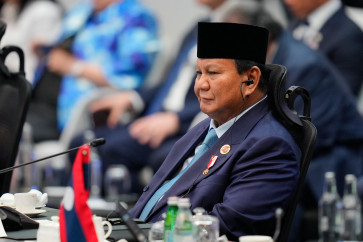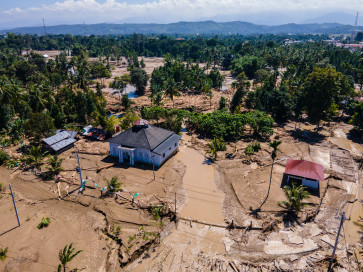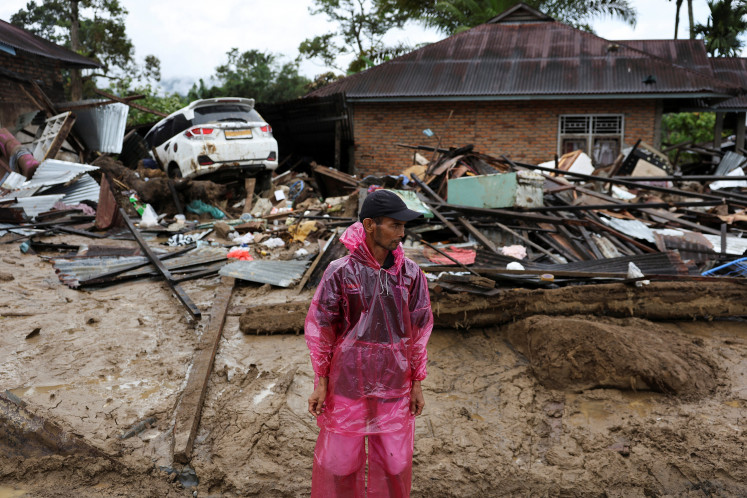Popular Reads
Top Results
Can't find what you're looking for?
View all search resultsPopular Reads
Top Results
Can't find what you're looking for?
View all search resultsInclusive social protection for poverty alleviation
Indonesia has emerged as a middle-income country and an important player in the global economy (G20) but faces three major problems: a slowing reduction of poverty rates, rising inequality and a high level of vulnerability for much of the population living in poverty
Change text size
Gift Premium Articles
to Anyone
I
ndonesia has emerged as a middle-income country and an important player in the global economy (G20) but faces three major problems: a slowing reduction of poverty rates, rising inequality and a high level of vulnerability for much of the population living in poverty.
As of September 2015, 28.51 million Indonesians (11.13 percent) lived below the poverty line, with the poor experiencing worsening socio-economic conditions.
Around 70 million people lived just above the poverty line and were vulnerable to economic shocks or other crises ' such as ill-health or unemployment ' which could push them into poverty.
In fact, over 80 percent of the population lives on less than Rp 32,000 (US$2.20) per day, which isn't even enough to buy a cup of coffee at Starbucks. Indonesia's Gini coefficient, which indicates inequality in income distribution, is 0.41, its highest in 50 years and the highest among Asian countries. If it continues to rise, Indonesia could be at risk of social instability.
According to the 2015-2019 Medium-Term Development Plan (RPJMN), the government aims to address the three above-mentioned major problems using four inter-linked strategies, which are: building a strong foundation for economic growth resulting in quality employment opportunities; establishing a comprehensive social protection system; promoting sustainable livelihoods; and increasing and expanding basic social services. By 2019, as projected in the RPJMN, the poverty rate and Gini coefficient are expected to fall to 7-8 percent and 0.36, respectively.
Social protection has been rebranded and expanded by the government through the Prosperous Family Savings Program (PSKS) that gives direct assistance to the poorest 25 percent of the population.
This program is implemented through the Smart Indonesia Program (PIP) and the Healthy Indonesia Program (PIS). The government also continues to implement other social assistance programs such as subsidized rice for the
poor (formerly known as Raskin) and the conditional cash transfer program (PKH).
As has been the norm, social protection programs are targeted at different segments of the population. Poverty targeting continues to be employed despite the fact that it generates high inclusion and exclusion errors, and, due to its complexity, is administratively expensive to deliver.
Stephen Kidd of Development Pathways (2016) has noted that 'in developing countries, there is no poverty targeting mechanism that comes remotely near being accurate in identifying people living in poverty.
Even well-known schemes such as Brazil's Bolsa Familia and Mexico's Oportunidades programs excluded 49 percent and 70 percent respectively of their target populations.'
Indonesia uses the Unified Data Base (UDB) as the basis for social protection targeting. But, as recent research has shown, it faces the challenge that, among the poorest 40 percent of the population covered by the UDB, a high percentage was not on the UDB.
On the other hand, a significant proportion of the richest quintile of the population are on it. Consequently, one cannot expect Indonesia's targeted social protection programs to be effective in reaching the majority of those living in poverty and vulnerability.
Furthermore, as pointed out by Amartya Sen (1995), the beneficiaries of poverty targeting tend to be politically weak, with minimal influence over electoral results.
And, there is good evidence that poverty targeting can create social tensions in communities, since those excluded from social protection programs become jealous of those who are included as beneficiaries.
So the question is why continue targeting? For its advocates, the argument for targeting rests on moral and resource arguments.
The moral argument is to prioritize the poor over the rich, yet, in reality, it is only universal programs that can ensure the inclusion of the poor. The resource argument is to ensure that limited budgetary resources are used effectively, yet, if half of the poor are excluded, can it be considered effective?
Given that poverty targeting's disadvantages outweigh its advantages, it is time to look into the alternative approach of inclusive lifecycle social protection as a means of reaching the poor and vulnerable and addressing inequality.
In contrast to poverty targeted schemes, inclusive provision offers better and larger contributions (transfer value) to beneficiaries.
Large scale and inclusive provision can have multiple benefits beyond the immediate purpose of helping the most vulnerable groups like the elderly, children and people with disabilities.
For example, grandmothers in receipt of old-age pensions can care for their grandchildren, to enable their mothers to find work (and further reduce poverty).
And inclusive social protection can generate higher levels of spending in the economy, which can help stimulate economic growth.
Inclusive social protection could reach the 80 percent of the aforementioned Indonesian population that continues to live in insecurity on less than Rp 32,000 per day. As a result, it can build social cohesion and reduce the risk of political instability.
Providing inclusive lifecycle social protection schemes for the majority of Indonesia's population ' and guaranteeing access for the most disadvantaged and vulnerable ' is affordable.
For just over 1 percent of GDP, Indonesia could provide comprehensive benefits for the vast majority of older people, children and people with disabilities, significantly improving the impact of the national social protection system.
Not only is inclusive social protection socially and economically desirable, but importantly ' as evidenced in many developed and developing countries ' it would be politically popular and would subsequently translate into support for expanding the fiscal space available for financing social protection, while reaping electoral rewards for ambitious and far-sighted policy makers and politicians.
Given the advantages of inclusive social protection, it is sensible for the government to explore the feasibility of piloting, if not implementing it across all areas of social policy, including inclusive old-age grants, child benefits and disability benefits. Our Constitution guarantees the right of all citizens to social security, and it is time that that right is fulfilled.
___________________________________
The writer chairs the Institute for Democracy Education (IDe) ' a Jakarta-based thinktank promoting democracy and human development.










